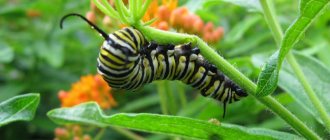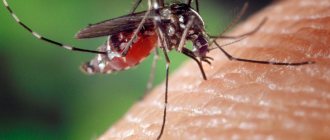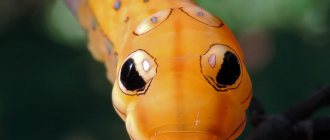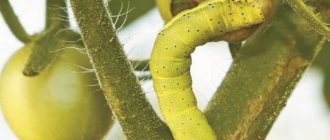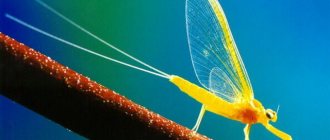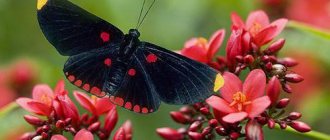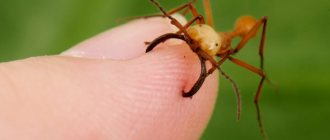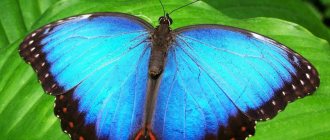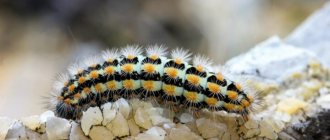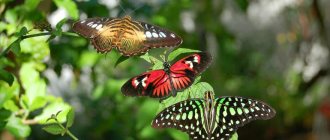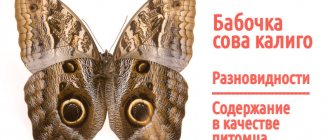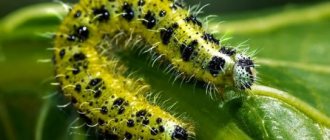AVENE Mattifying fluid 50 ml
1225 ₽ More details
Avene Sunscreen spray, SPF 30, 150 ml
1646 ₽ More details
Avene lotions
Butterflies are probably the most defenseless creatures of nature. They live short lives and serve as food for birds, frogs, lizards, hedgehogs, mice, rats, spiders, mantises and other predators. Almost 80% of butterflies are eaten in the caterpillar stage of development. Nature took care of some types of winged insects by endowing them with poison. Poisonous butterflies live everywhere, but there are especially many of them in southern countries - Africa, Australia, and Latin America.
There are many types of poisonous butterflies
How butterflies protect themselves
Some Lepidoptera acquired the color of their wings, allowing them to blend in with their environment: brown - the color of tree trunks, while blue ones are inconspicuous in flight, against the sky. There are also white representatives that blend in with the flowers. Brightly colored butterflies tend to have an unpleasant taste, and birds will spit them out.
Since butterflies most often die in the caterpillar state, since caterpillars are slow and clumsy, some individuals have villi on their bodies that cause intestinal irritation. Birds avoid unpleasant fuzzy larvae. The swallowtail caterpillar secretes a substance that repels birds with its smell.
It is noteworthy that blueberry butterflies are protected by ants. Little workers find bluebird larvae and bring them to the anthill. The larvae develop and turn into caterpillars. The caterpillars feed on ant larvae, and the ants feed on the substance secreted by the blueberry caterpillar. Thus, the caterpillars find themselves protected in the anthill. This is where they feed and winter. Well, the most aggressive type of defense is toxicity.
Blueberries are very beautiful
Daytime peacock eye
Daytime peacock's eye - the butterfly lives throughout Eurasia, with the exception of the tropics and tundra. This bright insect inhabits meadows and forest edges, city parks and forest belts, banks of rivers and lakes, and climbs mountains to a height of up to 2500 m. The butterfly lays eggs on the underside of a nettle leaf. The pupal stage lasts one to two weeks, and the caterpillar stage lasts two months. In temperate climates, the day eye produces one generation per summer, in the south - two or even three. Caterpillars feed on the leaves of nettles, burdocks and hops, and butterflies drink nectar and juice of different plant flowers.
Daytime peacock eye
When we talk about endangered species, we often think of bears, whales, pandas, gorillas or wolves. But there are also small animals that are in danger of extinction, including some types of insects. The Indians of South America believe that if you hang a picture of a butterfly at your head at night, you will see something good in your dreams. According to another belief, if a butterfly flies into your house, then someone’s wedding will soon take place in the family. Insects, in addition to being food for animals, also play a very important role for all natural ecosystems: they pollinate flowers, distribute seeds, contribute to the reproduction of dead animals and plants, and fertilize the earth.
Which butterflies are the most dangerous?
There are poisonous lepidoptera in Europe. People gave them truly royal names: monarch and their closest relative, viceroy. The only difference between them is that one of them has a black stripe on its wings, while the other does not have this stripe.
The monarch acquires its poisonousness while it is in the state of a caterpillar, which feeds on poisonous cottonweed. The Viceroy produces the poison himself. These butterflies are especially dangerous to birds.
What other poisonous butterflies live on earth are indicated in the table.
| Name | Habitat area | Color | Why is it harmful and dangerous? |
| Papilio Antimachus or Antimachus swallowtail. | Uganda | The butterfly is large, its wingspan reaches up to 20 cm. The swallowtail has long brown-orange wings with black spots. Paws are well developed. | She actually has no enemies, because all living beings tend to stay away from her. In a state of stress or fear, a sailboat releases an unpleasant-smelling, dangerous substance into the atmosphere |
| Green Emperor – Charaxes candiope | Its yellow-brown wings have green streaks. | The aggressiveness of this insect is reflected in the Guinness Book of Records as the most aggressive and fearless butterfly. She herself attacks her enemies and drops poisonous “bombs” of toxic substances on them. | |
| Urania | Tropics | Metallic shine of wings | Urania lays larvae on euphorbia plants containing poisonous juices. The larvae feed on this plant and get used to it, and they themselves accumulate poison in their bodies. Then this poison becomes a means of protection against birds, animals and predatory insects. |
| Heliconids | They received their sunny name for their red and yellow color. | Heliconids also pose a danger to humans. These lepidopterans produce poisonous cyanide from the food they eat. |
Butterfly pest exclamation scoop and the fight against it
The moth is a butterfly 35-45 mm in size, the front wings of which are single-colored, with almost no transverse stripes. The male has light, yellowish-gray wings.
The females are dark brown or dark brown. The hind wings of the male are light, while those of the female are brown.
The egg is 0.7-0.9 mm in size, grayish. The caterpillar's body is matte, yellow-brown or gray-brown. The pupa is 16-20 mm in size, yellow-brown, with two spines on the dorsal side.
Caterpillars overwinter in the soil. In spring, their pupation is observed in the surface layer of soil. The butterfly season begins in the first half of June.
Pests lay eggs on the soil, dry plant debris, or on leaves of cultivated plants and weeds located close to the ground. After 2 weeks, caterpillars form, which can feed on almost all vegetable crops growing on the site.
To combat the cutworm, it is recommended to spray the plants with an infusion of calendula seeds with the addition of garlic. To prepare it, you need to mix 4 cups of calendula seeds and 100 g of garlic minced through a meat grinder. Pour 10 liters of boiling water over the resulting mixture and leave for 3 hours. Spraying should be carried out once a week in the evening. Treatment must be stopped 30 days before harvest.
Which butterflies are dangerous at the caterpillar stage
The golden silkworm lives on the territory of Russia. The white butterfly itself is harmless, but the poison that causes allergies in humans is contained in the caterpillar. The golden silkworm or moth is also found in Europe and North America.
Read on topic:
Features of the life activity of ladybugs
14.11.2020
Description of chironomids and their possible danger to humans
14.11.2020
What do cutworms look like and what harm do they cause?
14.11.2020
What do goliath beetles look like and can they be bred at home?
14.11.2020
Ursa Kaya is a dangerous species of butterfly
The bear Kaya is another representative of poisonous Lepidoptera. Lives in Russia, Europe and Asia. The front wings are brown and white, the hind wings are orange with blue round spots. It is poisonous at all stages of development, starting from the larva.
The Kotzebue butterfly, or its second name kochubey, is blue-black with crimson speckles. It also poses a risk to birds and small animals due to the accumulation of toxins during its caterpillar state. Lives in the Philippine Islands and Malaysia. The local population calls this insect the purple rose.
For the most part, the poison of butterflies is dangerous for birds, small animals and insects that dare to feast on the flying beauty or its caterpillar. But there are individuals that can incapacitate a person.
Goldentail
The poisonous butterfly from the family of moths is also called the golden moth and the golden silkworm. In Europe, it is distributed from the shores of the Mediterranean to southern Sweden and Finland, and is found in eastern Russia and North America.
This is a small insect with white furry wings, the span of which reaches only 3-4 centimeters. The butterfly lives in mixed forests, cool orchards and parks, causing significant damage to trees.
The lacewing is poisonous at the caterpillar stage. You can recognize it during this period by its brown color with yellow-white longitudinal stripes and tufts of long brown hair. After touching the caterpillar, it becomes harder to breathe, and the skin develops rashes and scars. Symptoms can be managed with a calcium chloride compress and antihistamines.
How can you get poisoned?
Of course, a person does not eat butterflies, and he cannot eat a poisonous individual (like mushrooms) by mistake. However, poisonous butterflies can cause harm to humans. Some individuals are allergenic and, in contact with the skin, they can provoke an allergic reaction of varying severity.
Lonomia caterpillars are very poisonous
People who often vacation in exotic countries or on islands simply need to know the danger that butterflies that are poisonous to humans pose. You should not try to catch them, you should not contact them. For example, the Lonomia butterfly lives in humid forests, which is extremely dangerous as a dark-colored caterpillar with spikes.
It contains toxins that block blood clotting. Probably everyone knows how dangerous such a disease is. Bleeding occurs that cannot be stopped, and internal bleeding poses a greater danger than open bleeding. Brain hemorrhage may occur.
Lonomy caterpillars hide in the foliage of trees, and inquisitive tourists and local farmers often become their victims. A person who has been poisoned needs medical attention. Otherwise, death is possible.
The hairy caterpillar is a fluffy and cute creature that you just want to touch. She lives in the northern USA. However, this cute creature is insidious: under the soft, delicate fluff are hidden thorns, which, when broken, inject poison under the skin. The person experiences all the signs of acute poisoning. However, these signs go away on their own after 1-5 days, depending on the amount of poison received.
From this video you will learn about the most dangerous insects:
Appearance
Like other insects, its body consists of three main sections: head, chest (thorax) and abdomen. Three pairs of legs are attached to the thoracic region, each of which consists of four segments. The legs of the first pair are often very weak, and therefore the butterfly keeps them folded just below the head. The butterfly's vision is relatively good, although the antennae, which are the most powerful sense organs, are much more important for it. They grow from the front of the head and are able to detect odors over a long distance. This happens thanks to thousands of tiny holes that serve as excellent olfactory organs. Butterflies use their antennae to search for food and mates. They clean their antennas frequently, keeping them in good "working" condition. Having sat down to rest on a flower, the butterfly can almost immediately begin sucking the sweet flower nectar. Why does it roll out its long proboscis, like a tubular tongue? The proboscis can penetrate deep into the base of the flower, where nectar is stored.
However, in matters of taste, the butterfly relies not only on the tongue - it can taste the leaves through the legs. By feeling the surface of the leaf with her paws, she can determine whether it is suitable for laying eggs. Sometimes it is not easy to distinguish a male butterfly from a female. But some species have clear distinctive features. For example, the male of one species of butterfly, the white butterfly, has orange markings on the tips of his wings, while the female has pure white wings. The eyes of insects consist of small eyes called ommatidia. Each ommatidium ends with a facet - a hexagonal lens. Therefore, insects see the world as a mosaic consisting of tiny hexagons. Butterflies are distinguished from other insects primarily by four large wings with a bright, memorable pattern. The color and pattern of the wings is the most important characteristic of a butterfly species. Of which there are about 140 thousand species. The front pair of legs of butterflies is shortened and covered with thick hairs - for butterflies this is a taste organ. The coiled proboscis of the sucking mouth are elongated lower jaws.
What are the 2 most dangerous butterflies that live in Europe?
The most dangerous butterflies for humans that live on the European continent include the goldentail and the common bear. The goldtail has white translucent wings and is unremarkable in appearance. However, both its caterpillar and butterfly have hairs, upon contact with which a person can get an allergic reaction.
The butterfly lives everywhere, right up to northern Finland. There are especially many of them on the Mediterranean coast, which is rich in forests and parks. Tactile contact with lacewings leads to an allergic reaction.
You cannot rub your eyes with your hands at this moment, because if a hair remaining on your fingers gets into the eye, conjunctivitis will begin, and you will no longer be able to do without the help of a doctor.
The common bear can be found in Russia, the Caucasus and the Urals. She has an interesting color of her wings: the front ones are white with brown spots, the back ones are orange with black spots. The bear's body is shaggy, as if the beauty was wearing a fur vest. And this “vest” causes trouble for people and animals who dare to get closer to the beauty. The corpuscle villi cause an allergic reaction. And if the lint gets into the eye, then conjunctivitis occurs.
In Russia, one of the most dangerous is the common bear.
Butterfly-pest of the garden and vegetable garden hawthorn (with photo)
The hawthorn is a large, light-colored butterfly from the whitethorn family. It has white wings with black veins, the span of which is on average 5-6 cm.
The caterpillars of this butterfly, a pest of gardens and vegetable gardens, cause the greatest harm to fruit trees because they eat the leaves. The pest weaves a web around them, making nests in which it overwinters.
In the spring, when the flower buds of the apple tree are just beginning to bloom, the caterpillars leave their shelter and begin to gnaw out the buds, then damage the leaves, leaving only thick veins.
Hymenoptera parasitic insects play a significant role in reducing the number of hawthorn caterpillars.
What is first aid?
After contact with poisonous butterflies, a person develops redness on the skin; the poison can cause itching and burning. In case of severe poisoning, or severe sensitivity of a person to this allergen, the temperature may rise, nausea, and muscle soreness may appear.
If a painful condition occurs as a result of contact with one of the poisonous beauties, you must:
- apply ice to the point of contact, which will slow down the blood flow and prevent the spread of toxins throughout the body;
- apply a constricting bandage that will limit the spread of poison through the bloodstream;
- treat the open wound with a bactericidal agent;
- Give the patient an antihistamine.
A person suffering from allergic reactions should always have histamines with him when going on vacation anywhere.
Sailboat antimah
Antimachus is the largest butterfly on the African continent. Its wingspan is 18-23 centimeters. It is painted in an ocher color, against which there is a pattern of brown and black lines and spots. The front wings are oblong and strongly elongated upward.
The Antimach swallowtail has no natural enemies, because it is one of the most poisonous butterflies in the world. It lives in the tropical rainforests of equatorial Africa - from Liberia and the Republic of Cote d'Ivoire to Uganda and the Democratic Republic of the Congo.
